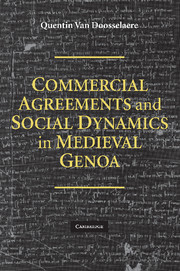Book contents
- Frontmatter
- Contents
- List of Figures
- List of Tables
- Abbreviations
- Acknowledgments
- 1 From Sword into Capital
- 2 Genoa at the Dawn of the Commercial Expansion
- 3 Equity Partnerships for Heterogeneous Ties
- 4 Credit Network for Routinized Merchants
- 5 Insurance Ties for Oligarchic Cohesion
- 6 Conclusion
- Appendix A Sample of Prices and Income
- Appendix B Sample of Long-Distance Trade Participants' Occupations
- Appendix C Commenda Network Graphs
- Appendix D Nodal Degree Distributions of Commenda Networks
- Appendix E List of Top Mercantile Nonaristocratic Families
- Appendix F Partner Selection Probability Model
- Bibliography
- Index
3 - Equity Partnerships for Heterogeneous Ties
Published online by Cambridge University Press: 31 August 2009
- Frontmatter
- Contents
- List of Figures
- List of Tables
- Abbreviations
- Acknowledgments
- 1 From Sword into Capital
- 2 Genoa at the Dawn of the Commercial Expansion
- 3 Equity Partnerships for Heterogeneous Ties
- 4 Credit Network for Routinized Merchants
- 5 Insurance Ties for Oligarchic Cohesion
- 6 Conclusion
- Appendix A Sample of Prices and Income
- Appendix B Sample of Long-Distance Trade Participants' Occupations
- Appendix C Commenda Network Graphs
- Appendix D Nodal Degree Distributions of Commenda Networks
- Appendix E List of Top Mercantile Nonaristocratic Families
- Appendix F Partner Selection Probability Model
- Bibliography
- Index
Summary
Around the year 1155, Genoa, reacting to the military threat of the German Emperor Barbarossa, undertook a vast renovation and consolidation of its fortified wall. The footprint of the wall provides us with a fairly precise measure of the town of 55 hectares (about 120 acres) and, thus, with a solid base from which to estimate Genoa's population at the time to be 30,000 to 40,000. While the mountainous terrain surrounding Genoa certainly created one of the most densely populated towns in Europe, its population was surpassed by several other Italian cities, such as Venice, Bologna, Milan, and Naples. On the Mediterranean Sea, though, Genoa was rapidly catching up with Venice to become one of two dominating Mediterranean powers. First dominating the western basin, Genoa was soon to share with Venice the eastern part as well. It was during this period that Italian cities enjoyed the rapid commercial expansion that set the stage for Western economic supremacy during the Renaissance and, ultimately, the rise of capitalism.
From 1150 to 1300, Genoa's trade grew steadily, so that, by the beginning of the fourteenth century, Genoa might well have been the wealthiest city in the wealthiest part of Europe, with its power extending from its commercial dealings in Bruges to its colonial dominion in the Black Sea.
- Type
- Chapter
- Information
- Commercial Agreements and Social Dynamics in Medieval Genoa , pp. 61 - 117Publisher: Cambridge University PressPrint publication year: 2009

